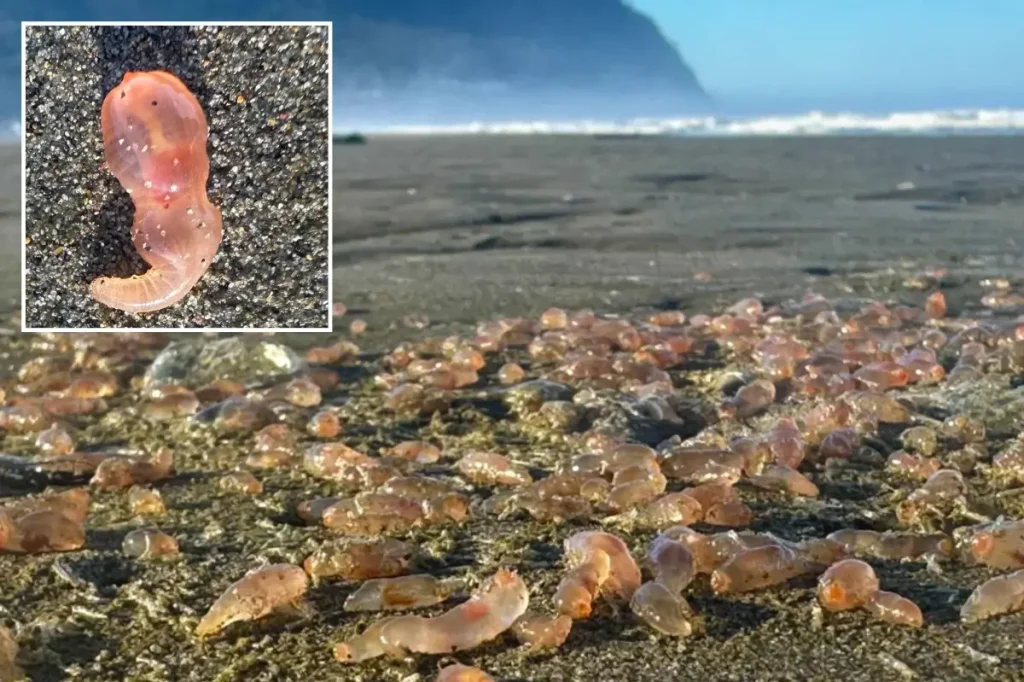Sea Cucumbers Wash Ashore in Oregon: A Natural Phenomenon Explained
In a striking natural event, thousands of skin breathing sea cucumbers recently washed up along more than two miles of Seaside Beach in Oregon. These small, partially translucent, pink gelatinous creatures typically remain hidden, burrowing into the sand along the low tideline and beyond. However, this week, beachgoers discovered them scattered extensively across the shore, creating what Tiffany Boothe, assistant manager of the Seaside Aquarium, described as literally “littering the tideline.” These fascinating marine animals, scientifically known as Leptosynapta clarki, typically measure just half an inch in length, though they can grow to about six inches, and inhabit coastal areas from northern California to the Gulf of Alaska.
This mass stranding event results from a specific combination of environmental conditions – heavy surf and low tides – that occasionally align to displace these delicate creatures from their sandy homes. While such phenomena can occur multiple times yearly or only once every few years, Boothe noted this particular occurrence was especially significant, featuring large groupings of sea cucumbers rather than the scattered individuals sometimes seen. The last time she witnessed comparable numbers washed ashore was several years ago, highlighting the relative rarity of an event of this magnitude. These natural stranding events offer a fleeting glimpse into marine life that normally remains hidden from human observation in the coastal town situated about 80 miles northwest of Portland.
Unfortunately for these displaced sea cucumbers, their appearance on shore represents a one-way journey. Unlike some marine animals that can survive temporary beach strandings, these particular sea cucumbers lack the mobility and physiological adaptations needed to return to their underwater habitat. As Boothe explained, once washed up on the beach, they inevitably dry up and perish, unable to make their way back to the moist sand environment where they normally thrive. This harsh reality underscores the precarious nature of marine life when subjected to the powerful forces of ocean currents and changing tides, forces that have shaped coastal ecosystems for millennia.
While the fate of these individual sea cucumbers might seem unfortunate, their death becomes part of the broader coastal nutrient cycle. Their remains provide valuable nourishment for various beach-dwelling invertebrates, including beach hoppers and beach fleas, that will feed on the organic material. Interestingly, Boothe noted that birds typically don’t consume these particular sea cucumbers, perhaps due to their gelatinous texture or chemical composition. Whatever portions of the sea cucumbers aren’t consumed by other creatures will quickly dehydrate under the coastal sun and wind, eventually blending seamlessly with the surrounding sand, leaving little trace of this remarkable event within days.
The transient nature of this phenomenon speaks to the dynamic character of shoreline ecosystems. Boothe predicted that by Wednesday or Thursday following the stranding, nearly all evidence of these thousands of sea cucumbers would disappear from the beach. This rapid integration back into the environment highlights how coastal areas constantly change through natural processes that often go unnoticed. The cyclical nature of such events – from the sea cucumbers’ lives in the sand to their occasional displacement and eventual return to the ecosystem as nutrients – exemplifies the interconnectedness of marine and shoreline habitats.
For visitors to Seaside and other coastal communities, phenomena like this sea cucumber stranding offer valuable opportunities to connect with and learn about the often-invisible marine world. While these particular animals might not be as famous as whales or sea turtles, their appearance provides a window into the diversity and complexity of ocean life. Such natural events remind us that beneath the surface of our familiar beaches lies an entire ecosystem of creatures that occasionally make themselves known through these unusual but ecologically significant occurrences. Though the sea cucumbers themselves won’t survive their unexpected journey to shore, their brief appearance enriches our understanding of the coastal environment and the countless species that call it home.


